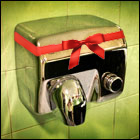|
Dandywalken posted:Tried to schedule a timing chain and water pump change at local Toyota dealership (2009 4Runner, 283k miles) after learning from previous owner it had never been done. I was under the impression for tge v6 it was to be done at 250k miles, but the dealership said they dont replace that part unless its showing signs of failure. I donít know of any manufacturer with a replacement interval for timing chains. Youíre right, it could break and potentially be a catastrophic failure, but itís a relatively unlikely event. Nothing on the maintenance schedule indicates you should replace it preventatively. However, it does seem that there is a version with a timing belt (2UZ-FE engine), and like most belts, it has a replacement interval. If you have that, get that thing replaced pronto. nitsuga fucked around with this message at 21:10 on Jan 26, 2024 |
|
|
|

|
| # ? May 30, 2024 03:08 |
|
Finally got through to the dealer: To answer my own question, the 84 month warranty on a Toyota TrueStart battery is useless without the original purchase receipt, even though there are stickers all over it with the date of install.
|
|
|
|
Warranties are always lies
|
|
|
|
Ethics_Gradient posted:Finally got through to the dealer: Contact the dealer where you bought it? Seems like they should have it on file.
|
|
|
|
LegoMan posted:Contact the dealer where you bought it? Seems like they should have it on file. Nope, car is a 2006 I bought it from a Toyota specialist who was using it as their courtesy car. They probably would have it on file if they'd been the ones who replaced it, but they had only owned it two years or so after buying it from a customer who balked at the cost of a hybrid battery replacement (the 12v battery would have been replaced not too long before the shop bought it from him, according to their records). Although their own service history was well documented, unfortunately they had nothing from the PO, so I'm out of luck. Ethics_Gradient fucked around with this message at 01:26 on Jan 27, 2024 |
|
|
|
Safety Dance posted:How do core charges work with RockAuto? Do they expect me to ship the old battery back to them? Is there any problem if I choose to eat the $18 and drop it off at the recycling center instead? Not worth it for the battery but on other parts iirc you can get a shipping label from them and they'll deduct the shipping costs from your refund.
|
|
|
|
Ethics_Gradient posted:Nope, car is a 2006 I bought it from a Toyota specialist who was using it as their courtesy car. They probably would have it on file if they'd been the ones who replaced it, but they had only owned it two years or so after buying it from a customer who balked at the cost of a hybrid battery replacement (the 12v battery would have been replaced not too long before the shop bought it from him, according to their records). Although their own service history was well documented, unfortunately they had nothing from the PO, so I'm out of luck. The terms of every part warranty I've ever seen only extend to the original purchaser. If you bought the car with that battery installed, it had no warranty for you.
|
|
|
|
Any other goons here at Daytona for the 24hr? We have 7 sim race goons here with beer, find us.
|
|
|
|
General question, why did older automatics have worse gas mileage than manuals? Was it related to them having less gears and therefore a harder time staying in the optimal rev range for economy, or was it related to power loss through the lovely torque converters, or something else? I know modern automatics frequently have better mileage but they also have like 7-10 speed gearboxes so IDK if it's the better torque converter technology or having enough gears that they can always be where the RPM wants to be for economy.
|
|
|
|
22 Eargesplitten posted:General question, why did older automatics have worse gas mileage than manuals? Was it related to them having less gears and therefore a harder time staying in the optimal rev range for economy, or was it related to power loss through the lovely torque converters, or something else? I know modern automatics frequently have better mileage but they also have like 7-10 speed gearboxes so IDK if it's the better torque converter technology or having enough gears that they can always be where the RPM wants to be for economy. Lock-up torque converters and computer control have been the main improvements.
|
|
|
|
22 Eargesplitten posted:General question, why did older automatics have worse gas mileage than manuals? Was it related to them having less gears and therefore a harder time staying in the optimal rev range for economy, or was it related to power loss through the lovely torque converters, or something else? I know modern automatics frequently have better mileage but they also have like 7-10 speed gearboxes so IDK if it's the better torque converter technology or having enough gears that they can always be where the RPM wants to be for economy. If it was gearing I'd expect they would just change the gearing. First suspect would be inefficiency due to friction with the fluid. Did the early ones even have solenoid actuation? I suspect they are able to optimize away a lot of unnecessary energy loss these days by controlling flow and pressure channels.
|
|
|
|
So you're saying the engine would have to work harder to spin the auto transmission so even at the same RPM it would be under heavier load? That would make sense. IDK anything about auto transmissions aside from most of them having lock-up torque converters by the late '80s to early '90s. I've just been thinking about them more since I'm trying to figure out if my SVX's auto got fried from losing a ton of fluid thanks to a hose backing off the radiator nipple.
|
|
|
|
Up until the mid-late aughts a lot of cars still had three and four speed autos vs their five speed manuals, so that contributed for sure. GM cars held onto this for a long while.
|
|
|
|
Yeah, that's what I meant with the "fewer gears", they seemed to spread them out to have the same top gear ratio but that means having bigger gaps between gears which means if optimal fuel efficiency is at 2k RPMs or something and it stays in that gear between 1500 and 3500 RPM that's a lot more of a range away from optimal than if you can shift the manual at 2500 RPM. 3 speeds without overdrive just seem like they would be godawful over 50mph or so.
|
|
|
|
With tall gears and all day to get there a 2 spd powerglide can get good mpg. New autos seem to be programmed for fuel economy above all else, they're shifting into cruising gears halfway through a right turn.
|
|
|
|
Those early two-speed and three-speed automatics couldn't have much of a range between low and drive, so you'd have to pick a final drive ratio to sacrifice either acceleration or highway manners, and neither would do great at fuel economy. Also, very few three speeds (and pretty much nothing older) had lockup torque converters, so even at highway speed there was always a significant amount of slip. Once you got to four speed transmissions, most of those used the extra gear as an overdrive, and lockup torque converters become common. It's usually only locked in a highway cruise scenario, so you still have slip for the entire time spent accelerating and even some portions of steady-state driving. Some later four-speed autos started getting partial computer control to better manage shift points. Five and six speed transmissions generally coincide with full computer control and clutch-to-clutch shifting. Now you can have a locking torque converter that locks early (second or third gear, for example) and stays locked the rest of the time. More gears means both a wider range between first and top overdrive, and smaller steps along the way to keep the engine in its most efficient range. It's around here where automatics reach parity with manuals. The parasitic losses of an automatic are offset by the fact that the automatic is always sending power to the wheels, whereas the manual spends at least some of the time with the clutch in and between gears, with the engine running but providing absolutely no forward motion. Eight+ speed transmissions just take things to the logical next step. You get even more range between lowest and highest gears and you have even finer steps between them. Modern computer controls managing the engine and transmission together mean shifts can happen faster than before without any perceived harshness, stronger lockup clutches mean the torque converter now spends the vast majority of the time fully locked, and all of this combines to make autos more efficient.
|
|
|
|
22 Eargesplitten posted:Yeah, that's what I meant with the "fewer gears", they seemed to spread them out to have the same top gear ratio but that means having bigger gaps between gears which means if optimal fuel efficiency is at 2k RPMs or something and it stays in that gear between 1500 and 3500 RPM that's a lot more of a range away from optimal than if you can shift the manual at 2500 RPM. 3 speeds without overdrive just seem like they would be godawful over 50mph or so. They also used the 'slush' in the torque converter to 'fill in the gaps', as it were. The bottom gear was usually relatively high (more like 2nd gear in a manual) because the torque converter meant that there could be a lot of slip between crankshaft and transmission, with the torque converter providing, well, the torque. Imagine driving a manual transmission car where you could only pull away in 2nd gear - you'd have to slip the clutch a lot as you started off and at low speeds. That's how old autos behave, and it's not very efficient because a good deal of your fuel burn is being wasted in sloshing ATF around and heating it up in the torque converter. The early two-speed unit were the same for their high gear - make the gear quite high for good cruising and rely on the torque converter to take up the slack at lower speeds or under acceleration. The extreme example would be the early Hondamatic gearbox where you selected one of two fixed speeds and then drove it like an auto (throttle to go, brake to slow) but virtually all the work was done by the torque converter. The low speed gave perkier acceleration around town but was very thrashy at high speeds, while the higher speed gave higher cruising speeds and better fuel consumption but lethargic accleration. Pull away in an early Civic Hondamatic in the high gear and the engine pegs at about 2000rpm while the road speed gradually increases, like driving a twist-and-go scooter. Clever but very inefficient. At the other end of the scale, look at the AP Automatic transmission put into the Austin Mini in the 1960s. That was designed for economy and didn't have the torque of a big V8 to work with (just a 1098cc four-cylinder making about 40hp) so it had four very close together ratios and it is set up to very readily flick between them so the engine stays in its miniscule torque curve.
|
|
|
|
IOwnCalculus posted:The terms of every part warranty I've ever seen only extend to the original purchaser. If you bought the car with that battery installed, it had no warranty for you. Well, the receipt I just got from the dealer for the replacement (same place the old one came from according to the sticker) literally just said "Cash" for the customer name (I paid by card)  So effectively it's "make sure you hang onto this magic piece of paper, otherwise too bad for you". So effectively it's "make sure you hang onto this magic piece of paper, otherwise too bad for you". Surprisingly, getting an OEM Toyota battery at a dealership was a bit cheaper than an aftermarket at Autozone/O'Reilly/Amazon, glad I called.
|
|
|
|
Iím in California. I bought a new vehicle and want to sell my old vehicle private party. When I got insurance for the new vehicle I wasnít thinking right so I had them drop the old vehicle and add the new one. So now the vehicle I want to sell has no insurance. Itís currently parked and not being driven. Can I still sell this vehicle without insurance? Iím guessing no since itíll be a big issue with registration. If not can I just call my insurance and have them add it back again for a month or whatever?
|
|
|
|
FCKGW posted:Iím in California. I bought a new vehicle and want to sell my old vehicle private party. When I got insurance for the new vehicle I wasnít thinking right so I had them drop the old vehicle and add the new one. So now the vehicle I want to sell has no insurance. Itís currently parked and not being driven. If somebody buys it,. they'll immediately be covered by their own insurance. Selling it without insurance is not a problem. The problem will be taking it on test drives. If anything happens, you're not covered. Call your agent and get it added back on.
|
|
|
|
Deteriorata posted:If somebody buys it,. they'll immediately be covered by their own insurance. Selling it without insurance is not a problem. I'm in another state but had to do some research on this a few months ago, I believe the test driver's insurance would also cover them if they were driving another vehicle, but I also wouldn't take the word of a Marketplace random that they were insured, so definitely get the other car added back on.
|
|
|
|
I haven't driven my Forester XT since the end of June where it has been sitting in an open parking lot. I just started it up today to get it ready for inspection due at the end of February. Needed a jump but fired right up, idles just fine, and the battery charged up enough to crank without a jump. However, I can't get it into gear because the clutch doesn't seem to be disconnecting the transmission from the flywheel. I can feel pressure working the pedal and it doesn't feel out of the ordinary so I didn't know I had a problem until I was ready to drive it around the block. The clutch interlock also works though I don't know if that works by detecting the position of the pedal or sensing pressure in the clutch line. Either way I can't get it into gear which is definitely a problem. The details of how a clutch works is still a little murky to me but I'm guessing the pressure plate and flywheel may have rusted together to the point that the throwout bearing can't separate them? In any case, even though I do have the tools for it, I don't know what the gently caress I'm doing to be dicking around there let alone doing it in an open parking lot. Of course, that means I'll need to get the car towed to a shop to have any professional look at it since I can't get it into gear and not really feasible to push start it in gear and trundle along to a shop in 1st or 2nd gear. Is there anything else I can do that doesn't involve unbolting a lot of heavy poo poo to get the clutch to work? Or something that I can do to better diagnose where the problem is occurring if my assumption of the pressure plate and flywheel is off base?
|
|
|
|
Edward IV posted:I haven't driven my Forester XT since the end of June where it has been sitting in an open parking lot. I just started it up today to get it ready for inspection due at the end of February. Needed a jump but fired right up, idles just fine, and the battery charged up enough to crank without a jump. However, I can't get it into gear because the clutch doesn't seem to be disconnecting the transmission from the flywheel. I think I have heard of that happening if you don't drive a manual for a while. My first instict would be hitting the clutch/gearbox area with a rubber mallet a bunch and seeing if that might knock it loose.
|
|
|
|
Idle it and cycle your brake pedal and clutch a bunch. There might be some kinda air bubble or something in the fluid line for the clutch. Honestly it sounds much worse than that though. You should really not let a car sit for more than a month.
|
|
|
|
It sounds like a busted hydraulic line to me. That or the slave cylinder. A clutch shouldnít fail sitting for a few months. Questionable hydraulic lines though, definitely a possibility. That you can move the pedal is a good sign. Iím not sure how up for fixing it you are, but Iíd start by looking for leaks. Also make sure the reservoir has fluid in it, and that you know what type of fluid should go in it. Generally, DOT 3, but do verify before filling it up. If there arenít any leaks, then Iíd try bleeding it. Hereís a video a about that process: https://youtu.be/oGuadDl-pgM?si=7-Lma_iABgWkIH0b
|
|
|
|
22 Eargesplitten posted:So you're saying the engine would have to work harder to spin the auto transmission so even at the same RPM it would be under heavier load? That would make sense. IDK anything about auto transmissions aside from most of them having lock-up torque converters by the late '80s to early '90s. I've just been thinking about them more since I'm trying to figure out if my SVX's auto got fried from losing a ton of fluid thanks to a hose backing off the radiator nipple. The typical automatics on Saab 900s where three speed only vs manuals who where 5 speed, they also revved a lot higher than the manuals at cruising speed. Same story with the Saab 9000 and 2.3 engine, the latter 2.3 variants with manuals got some really good mileages (up to 39mpg), but only the manuals since the automatics revved a lot higher at highway cruising speeds. I still prefer manuals and have only ever driven one automatic, which was US import firebird. Just for the simplicity and durability of the manual alone, even if I can no longer put fuel efficiency on the list.
|
|
|
|
His Divine Shadow posted:The typical automatics on Saab 900s where three speed only vs manuals who where 5 speed, they also revved a lot higher than the manuals at cruising speed. Same story with the Saab 9000 and 2.3 engine, the latter 2.3 variants with manuals got some really good mileages (up to 39mpg), but only the manuals since the automatics revved a lot higher at highway cruising speeds. You've only ever driven once auto or owned one auto? I don't know how you could get away with never having driven more than one auto in your life, that's crazy.
|
|
|
|
Owned one auto, I can recall having driven two automatics. Both US cars. It does help that historically manual cars have been in the great majority.
His Divine Shadow fucked around with this message at 14:06 on Jan 28, 2024 |
|
|
|
Got a new(er) vehicle recently and the previous owner was a jackass. There are exactly 3 gouges in the paint all the way down to bare metal, all 3 are directly under the badges, and every single badge on the vehicle was rattle canned black. The finish looks bad, it's uneven and has runs. I disassembled the grill and swapped that emblem, then did some practice with the badge safely off of the vehicle. I found that I could peel off the paint using a plastic scraper, toothpick or even just my fingernails and it ended up looking brand new afterwards, possibly even better than the replacement I put on. I also found that I could let WD-40 soak for about a minute and then rub off the paint, this might work ok for the badges still on the vehicle but I'm afraid WD-40 might gently caress up my paint. I could attempt to remove the badges, but I don't want to risk gouging the paint like the PO did. I did one fender badge putting WD-40 on a paper towel then lightly scrubbing the raised area so that the WD-40 wouldn't contact the vehicle paint, once it was started I could peel off paint closer to the body. Is there a good way to protect the paint in case I accidentally got WD-40 on it? I'm considering masking tape, or maybe some clay or fresh Play-Doh. Could I put vaseline on the paint or is that also petroleum based enough to mess up the paint? Not Wolverine fucked around with this message at 05:00 on Jan 29, 2024 |
|
|
|
Edward IV posted:I haven't driven my Forester XT since the end of June where it has been sitting in an open parking lot. I just started it up today to get it ready for inspection due at the end of February. Needed a jump but fired right up, idles just fine, and the battery charged up enough to crank without a jump. However, I can't get it into gear because the clutch doesn't seem to be disconnecting the transmission from the flywheel. The interlock is just a contact switch that closes (or opens) based on pedal position. Because of this there is one easy sketchy thing you can try. Unplug that switch under your dash, stick it in first, and start it in gear (foot off the clutch). This will cause the car to start moving the moment you start cranking so make sure you're pointed in a safe direction and are ready to shut it off / stand on the brakes and stall the engine. If something's just a little stuck this might knock it loose.
|
|
|
|
Needed to use the jump pack again because either 45 minutes of idling isn't enough to charge the battery or the battery is hosed and can't hold a charge. I assume the clutch and brake reservoir are aligned with their respective pedals (Fake edit: watched the bleed video and turns out it's the other way around) but both have fluid as far as I could tell as the fluid color is rather subtle. Shining a light through the reservoirs does confirm I have fluid and that they are both at the full mark. I repeatedly worked the pedals to no avail. While the engine was still idling high, I could very subtly hear the revs drop when pressing in the clutch but no where near to same the extent when pressing the brakes. I guess brakes take more vacuum than the clutch. Now that I think of it, I believe that revs drop more noticeably when pressing the clutch than it does now though I could be misremembering as it was so long ago. I stopped the engine, put it into 1st, disengaged the hand brake, and tried to start it with the clutch in (took 2 tries as it turned out I hadn't forced the stick enough to pop it into gear) and the car lurched. (I'm facing out of the parking spot and there was no one around so this was the safe for what it is.) I didn't want to abuse the battery anymore than I already had so I immediately stopped. Started it again in neutral but it still won't go into gear. Watching the bleed video, it's going to be an extra pain in the rear end as it looks like I pretty much need to remove the intercooler to get to the clutch reservoir and the bleed nipple. Maybe I can give it a shot if I enlist some guys at work that know what they're doing or at least an extra pair of hands and eyes. With help, I may be more open to dropping the transmission or whatever it takes to get a look at the clutch. At least the weather into the middle of next week looks fair so I can do more work when things dry up. Edward IV fucked around with this message at 23:41 on Jan 28, 2024 |
|
|
|
Edward IV posted:Needed to use the jump pack again because either 45 minutes of idling isn't enough to charge the battery or the battery is hosed and can't hold a charge. Does the pedal go all the way to the floor? I've driven some pretty big trucks and lots of cars and none have had a power assisted clutch. So it wouldn't take any vacuum to operate the clutch. The full reservoir makes me believe that its not a leak. My initial impression was that the piston in the master cylinder has a bad seal and the piston itself is just moving back and forth, with no seal and thus not really pushing fluid anywhere. If that were the case though the reservoir might not be full and you might see some evidence of leaking inside the car or on the firewall in the engine compartment. Does the pedal return quickly? Smoothly?
|
|
|
|
Edward IV posted:Needed to use the jump pack again because either 45 minutes of idling isn't enough to charge the battery or the battery is hosed and can't hold a charge. Idling like that doesn't actually do much to charge your battery back up, it's driving around at higher RPMs that does. Starting the car obviously puts a big drain on the battery, so when you have to leave it to sit for a while it's best if someone can drive it around to run errands. Starting it up in the driveway and not going anywhere is a net negative in terms of battery health in those situations. In your situation, if you have a trickle charger your best bet would be to pull the battery and bring it home to charge.
|
|
|
|
It's possible I've confused which way the revs changed and it may have gone up when engaging the clutch with the engine no longer spinning the transmission input shaft. Again, it's a while ago and I tend to notice general changes but tend to neglect to remember the details. As for the clutch, the pedal does go to the floor and immediately and smoothly returns when I let go. As I mentioned before, I didn't notice anything off about the clutch pedal when pressing it for the starter interlock. For context, I've experience, with this car in fact, what it's like when the brakes are leaking and the clutch is no where close to that.
|
|
|
|
So I think I've finally found a good donor vehicle to body swap (01 Suburban 2500 with my 03 Sierra 2500), but it has power doors/windows. Is there something that has to be done to swap these out? I haven't looked at the fuse box yet to see, but it seems too simple to just ... plug it in.
|
|
|
|
We've got a 2021 Model Y Long Range with ~33k miles on the OEM tires w/ 19" wheels. I'm a dummy who didn't bother rotating the tires, so the rear tires are getting pretty worn. Anyway, I'm looking for tire recommendations. I'm in central Texas so we get rain, some brief periods of below-freezing temps but generally no ice or snow, and brutal heat in the summer. My brother put some variety of all seasons on his Model 3. Presumably they were not targeting EVs, because he tells me he's seeing somewhere close to 15% in range reduction. Obviously I'd like to avoid that.
|
|
|
|
Edward IV posted:It's possible I've confused which way the revs changed and it may have gone up when engaging the clutch with the engine no longer spinning the transmission input shaft. Again, it's a while ago and I tend to notice general changes but tend to neglect to remember the details. Clutch hydraulics don't suddenly need bleeding if they haven't been opened; something has failed, and I wouldn't waste my time trying to bleed the system just to bleed it. Is the clutch-side cylinder actually visible (it acts on a fork poking through the bell housing) or is it internal / part of the throw out bearing? If it's the former, get your eyes on the clutch fork while someone pumps the pedal. If it doesn't move at all or moves very little, it's either one of the hydraulic cylinders failing internally and letting pressure bleed by without actuating the clutch. If it moves a lot, you've got a problem with something inside the bell housing and at that point the transmission is coming off just to figure out what failed. If it's internal to the bell housing, I'd load a master cylinder into the parts cannon just for shits and grins in hopes that it avoids pulling the transmission.
|
|
|
|
2009 Corolla. Any reason why a bad O2 sensor would cause check engine, vsc and traction control lights to come on? Reasoning I'm being given is more or less "to get your attention".
|
|
|
|
Why is it the o2 sensor?
|
|
|
|

|
| # ? May 30, 2024 03:08 |
|
wesleywillis posted:2009 Corolla. That sounds more like a wheel speed sensor than an O2 sensor.
|
|
|




























